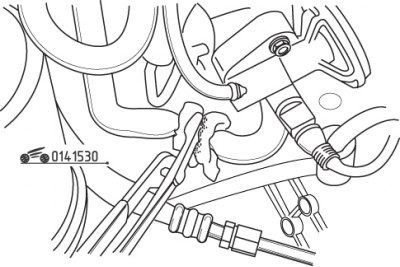
Pic. 15.24. Arrangement of pins on the air flow meter connector
Turn the key in the ignition switch to position «ON» and measure the voltage between each pin of the connector and «weight» (pic. 15.24). Compare the readings with those given in Table. 15.3.
Table 15.3. Voltage at the contacts of the air flow meter connector

If there is a deviation from the nominal voltage, check the main fuse, the main relay of the meter and the wires.

Pic. 15.25. Using a screwdriver to release the air flow meter connector retaining bracket
To disconnect the connector from the air flow meter, release the spring clip by prying it out with a small screwdriver (pic. 15.25).
Measure the resistance between the pins of the connector (see fig. 15.24). The resistance values are given in table. 15.4.
Table 15.4. Resistance between the contacts of the air flow meter connector in the initial position of the meter plate

Sharp (push) open the measuring plate and measure the resistance between the contacts in accordance with the table. 15.5.
Table 15.5. Resistance between the contacts of the air flow meter connector after the deflection of the meter plate

If the resistance deviates from the nominal value, replace the air flow meter.
To replace the air flow meter, loosen the clamp and remove the hose from the top cover of the air filter. Disconnect the connector and remove the vacuum hose from the air control valve.

Pic. 15.26. Mounting elements of the air flow meter: 1 - rubber ring; 2 - cover assembly; 3 - air flow meter
Separate the top cover of the air filter from the base and remove the meter from the top cover (pic. 15.26).
Installation is carried out in the reverse order of removal. Be sure to install the rubber ring between the meter and the top cover.
Attention! The position of the throttle adjusting screw is set by the manufacturer, adjustment during operation of the vehicle is not allowed.
Throttle assembly
Check for smooth movement of the throttle linkage. Seizure can be caused by tarry deposits on the back of the throttle body that travel from the crankcase ventilation system through a hose into the surge tank and intake manifold. To remove deposits, remove the throttle tube, open the throttle and clean thoroughly with fine sandpaper. Be careful not to damage the thin coating of the damper and the housing wall.

Pic. 15.27. The location of the fittings of the throttle assembly of the engine without turbocharging

Pic. 15.28. Arrangement of fittings of the throttle assembly of the turbocharged engine
Warm up the engine to operating temperature, check the vacuum at each fitting of the throttle assembly (pic. 15.27, 15.28) and compare the results with the data given in Table. 15.6, 15.7.
Table 15.6. Vacuum at the fittings of the throttle assembly of a non-turbo engine

Table 15.7. Vacuum at the fittings of the throttle assembly of a turbocharged engine

If the results are not as desired, clean or blow out the channels with compressed air.
If it is necessary to remove the throttle assembly, first of all disconnect the wire from the negative terminal of the battery.
Remove the air duct installed between the throttle assembly and the air flow meter.
Disconnect the throttle return spring.
Disconnect the throttle control cable from the lever.

Pic. 15.29. Typical fastening elements of the throttle assembly: 1 - vacuum hose; 2 - bypass air hose; 3 – a hose of a cooling liquid; 4 - throttle assembly; 5 - gasket; 6 - vacuum hose
Disconnect the vacuum hoses at the top of the throttle assembly (pic. 15.29).
Disconnect the connector from the throttle angle sensor.
Drain about 1.0 liters of coolant from the radiator. Disconnect the coolant hose and bypass air hose from the throttle body.
Loosen the four nuts and remove the throttle body.
Use a razor blade to clean the remnants of the gaskets from the expansion chamber and the throttle assembly, otherwise, after installing the throttle assembly, air leakage is possible.
Remove remaining tar deposits and dirt from the throttle body by flushing with clean solvent or carbon cleaner. Wash areas near the throttle valve especially carefully.
Attention! Do not immerse the throttle angle sensor in any solvent or cleaner. Otherwise, the plastic walls and the electronic circuit inside may be damaged.
If possible, blow out the vacuum channels with compressed air.
Installation is carried out in the reverse order of removal.
Checking the air valve

Pic. 15.30. Using pliers to pinch the bypass air hose
Start the engine and leave it to idle. In the process of warming up the engine with pliers, pinch the bypass air hose, the engine speed should decrease slightly (pic. 15.30). If this does not happen, check the tightness of the air valve and vacuum hose.
Warm up the engine to operating temperature. Pinch the hose again, the engine speed should decrease by 100–200 min-1. If the decrease in frequency exceeds 200 min-1, check for voltage at the air valve connector pins.
To check the voltage at the air valve connector pins, disconnect the connector and check the voltage supplied from the battery. If the voltage is low or absent, check the wires or the fuel pump relay.
Check the resistance of the air valve, which should be 30-45 ohms. If the resistance is not correct, replace the air valve.
To check the operation of the air valve, remove one of the hoses, attach a piece of hose and purge the valve, while the key in the ignition switch must be in the position «ON».
At a valve temperature not exceeding 20°C, air must pass freely through the valve. At temperatures above 20°C, the valve must be closed.
To replace the valve, loosen the clamps and remove the hoses. Disconnect the connector, unscrew the screws and remove the valve.
Installation is carried out in the reverse order of removal.
